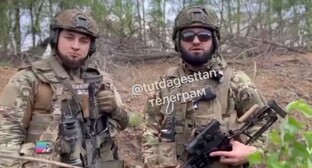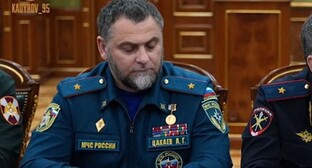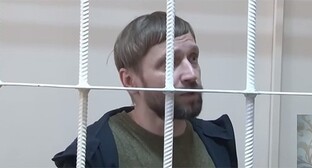16 January 2004, 02:04
Chechnya and Ingushetia in the Russian Empire
At the end of the Caucasian War the number of Vainakhs decreased due to military actions and departure to the Ottoman Empire. So, if in 1840 the total number of Chechens and Ingushes fluctuated between 170-290 thousand, in 1867 it fell to 143 thousand. Then the number of Vainakhs began increasing rapidly again. It was caused by a high index of natural multiplication. According to the 1897 census, they numbered 229,782 people, including 187,635 Chechens and 42,147 Ingushes. At the end of the period under review, in 1912 the total number of Vainakhs overran 300,000 (245,5 thousand Chechens and 56,4 Ingushes).
To keep the Vainakhs under obedience, the Russian government populated the lowland with Cossacks. In the mountains at strategically important points the Russians built fortresses and placed military garrisons. The age of colonial yoke began. Administration was of a military-police character. Though it could not break the spirit of national resistance: guerrilla detachments such as Baysungur, Atabaya, Soltamurad, Umi Duev and others that had been fighting yet under the flag of Shamil and had not laid arms after Gunib, acted in Chechnya in 1860-1861. A lot of local uprisings, taking place time to time, were severely subdued by the authorities. "Unreliable" auls were resettled by force in the lowland surrounded by Cossacks villages. Folklore memorials, created after the conquest of the Caucasus by Russians, express the emotions of freedom-loving nation that appeared under the oppression of autocracy. One Chechen song sings:
Belt on a thin figure
Change with
A sash -
Orders a tsar to you.
Well preserved
Chechen clothes
With rags replace -
Orders a tsar to you.
A tall fur cap of yours
Made of scribble
With a hood replace -
Orders a tsar to you.
A steel arm
Of your fathers
With a stick replace -
Orders a tsar to you.
Climb down of your horse,
Brought up with you,
Pedestrian become -
Orders a tsar to you.
Be calm and become a slave of
Murderers of your brothers,
Not believing in God -
Orders a tsar to you.
Lie down to sleep with them,
On a common stand,
Eat with them from the same plate -
Orders a tsar to you.
Apart from the open military resistance, a mystical religious movement, Zikrism (Zikrullakh in Arabian, i.e., prayer-loving), sprang up in Chechnya in the beginning of the 60s. Sheikh Kunta Khadji, a preacher who was known for his honest lifestyle, perfect moral and diligence, called for peace and love of a neighbour. Kunta demanded from his followers (Muridists) to keep Shariat. A way-out of all misfortunes he saw in the God's kindness only. Zikrists danced and sang noisily at their group meetings.
In the beginning, the royal administration was loyal towards a peaceful movement of Zakrists, but a rapid increase in the number of Kunta's followers frightened it. In 1864 Kunta Khadji and his brother were arrested and taken out from Chechnya immediately. Several days later, nearly 3 thousand Zikrists gathered near the village of Shalli and demanded from the government to free their leaders. But the government refused. The authority used an army and artillery to disperse the crowd. But the believers with only sabers and daggers in hands attacked the army that was deployed in a military order. Bullets and case shots killed 164 Zikrists, among them were 6 women disguised as men. (Later Chechens called the tragedy "a fight with daggers"). Kunta Khadji was exiled to the Novgorod Province where he died from hunger and exhaustion in 1867.
After the Shalli manslaughter the tsarist administration banned Zikrism and threatened its followers by immediate exile from Chechnya. Though the movement went underground, some of its followers chose more radical forms of resistance. In 1865 Zikrist Taza Ekmirzaev declared himself being imam and tried to arrange an armed revolt. Appeals he distributed in whole Chechnya and Daghestan said: "Be ready for a holly war against the unfaithful, for their banishment from our country". But the movement did not spread and was subdued with the help of Chechen secular and ecclesiastic officials. Taza was caught and sent first to penal servitude and then to Siberia for permanent exile. Other activists and auls supporting them were also punished.
Popular uprising of 1877 was more numerous. It spread on greater parts of Chechnya and Daghestan. The tsarist administration, afraid of the recommence of the Caucasian War, used whole power to subdue the uprising. More than 30 thousand chastisers with an artillery holding 100 trunks acted in Chechnya only. The poorly armed rebels were broken. They retreated to almost inaccessible highland regions. As a rule, suppression of an uprising was followed by the extermination of auls. Punitive groups scoured about the roads killing everyone met. Such action aimed to evade by means of total terror even a thought of resistance. As a result of following reprisals Alibeg Khadji, Uma Duev and his son - Duda Umaev, Dada Zalmaev and other leaders of the uprising (11 people in the whole) were hung in Grozny. Over 500 people were exiled to Siberia and other northern provinces of Russia. (Total number of the rebels, together with Daghestans, exiled from the Caucasus for taking part in the uprising of 1877, overran 5 thousand).
Since then national resistance of the highlanders has been sharply showing itself in brigandage. Brigandage is an old phenomenon in the Caucasus. But it acquired a different shape after establishing of Russian domination there. Tsarist authority considered brigands to be robbers. But they should not be mixed with the common criminals. Those were the rebels who somehow came into collision with a state machine and not wishing to obey they took arms. Acting alone or by small groupings the brigands avenged authority for themselves and for their people: they killed hated officials, robbed banks, treasury establishments and rich exploiters. Frequently, brigands distributed the robbed money and jewelry among the poor peasants. Brigandage had a wide social support and, undoubtedly, reflected people's dissatisfaction caused by national and colonial oppression. People considered brigands to be their protectors and they also defended them by helping them hide from a tsarist themis. Therefore, brigands remained "elusive" for years.
During the tsarist domination the most famous Chechen brigand was Vara who was killed in a battle waged against the dragoon regiment in 1865. There were many famous outlaws (Geha, Mekhti, Uspan, Eska, Aub, Salambek and others), but in Chechnya and in the whole Caucasus the most famous of them was Zelimkhan from Karachoya. His epic lasted from 1901 to 1913 and was marked by really grand affairs. Rumors over Zelimkhan were highly spread in Russia. The authority fixed a large amount of money for his capture. Numerous punitive groups persecuted Zelimkhan. Tens of families and individuals suspected in helping and harboring him were exiled to Siberia; the whole societies were fined; quite a number of execution(1) groups were sent to the villages but people did not betray him. Many even hoped that Zelimkhan would declare himself being Imam and banish the Russians. Only in September 1913 the chastisers could eventually find seriously ill Zelimkhan and killed him.
Tsarist authority seemed to be afraid of mass uprisings under the leadership of religious leaders and outlaws like Zelimkhan. Therefore, about tens of the most famous sheikhs were exiled from Chechnya and Ingushetia to Russia in 1912.
* * *After the war between the Russians and highlanders, tsarist authority reorganized the region's administrative order, thereby trying to strengthen its domination over the conquered North Caucasus. Chechnya and Ingushetia entered the Terski Region formed in 1860. Besides the Vainakhs there also lived Kabardians, Ossets, Balkans, Nogais, part of Kumyk, etc. In addition, masses of indigent peasants who had been liberated from the serf necessity in 1861 moved to the North Caucasus from central parts of Russia. These Russian new settlers created a category of "strangers" (i.e. those who arrived from another town). They did not enjoy the rights of the Cossacks and depended on them in regard of land and economic dependence.
The civil, Cossack and highland populations of the North Caucasus were governed differently. All highland nations were under authority of so-called "military national" administration. It differed from the Cossack and general civil administration of the Russian Empire. The generals and officers who were entrusted complete powers ran the Terski Region, as well as its parts and counties. This system of administration, designed for nations' oppression, hampered the economic and cultural development of the region.
Land problem was especially acute. Over 90% of the population were engaged in agriculture until the beginning of the 19th century. Meanwhile, the Chechens and Ingushes, whose huge territories had been confiscated in favor of the fisc and Cossacks, lived in poverty because of lack of land. Situation was particularly hard in the mountainous regions where nearly 40% of households had neither arable nor hay fields. According to statistic data in average 1,2 dessiatinas of arable land was apportioned per 1 male inhabitant of Chechnya and 0,2 dessiatinas per 1 male inhabitant of Ingushetia, that came to average 0,7 dessiatinas in mountainous Chechnya and Ingushetia in whole. The contemporaries wrote that the harvest gathered by the mountaineer Ingushes was enough only just not to die from hunger. As to the Cossacks, they were well - provided with the arable lands in Sunzhenski section of the Terski Region and Kizlyar (10,7 and 27,5 dessiatinas per Cossack respectively).
Lack of land made the highlander peasants rent hundreds of thousand dessiatinas from the Cossacks, paymasters and private owners. In summers they had to leave for the Cossack towns and villages in order to earn money.
Impoverishment of the main part of Chechen and Ingush population was also a consequence of high state taxes imposed on people. Taxes increased from year to year. It is interesting that in 1866 the neighbouring Ossets, mainly confessing Christianity and twice outnumbering the Ingushes, paid only 10,000 rubles, while the latter paid 13,000 rubles. By 1889 taxes had increased and the Ossets as well as Ingushes paid already 17,000 rubles each. Obviously, it aimed at dividing the neighbours and bribing the coreligionist Ossets.
It goes without saying that the fact of existing of the prosperous and rich highlanders having in their possession enough lands, cattle, flocks of sheep and herds of horses do not contradict the above mentioned. Wealthy highlanders invested their capital in productions, set up stock companies, such as "Novoaldinskaya", "Staroutrovskaya", etc. The Chechen oil manufacturers, owners of factories and stores stood out too. But such people were few, of course.
It was impossible to live on agriculture only. Therefore, Vainakhs had to carry on cottage industries. In Chechnya and Ingushetia such industries as processing of metal, wool, silk, etc., remained to be pursuit of the mountaineers until the end of the 19th century. Their production satisfied not only local needs but was sold in other regions too. Felt boots, clothes and coldsteal of Chechen production was especially in great demand.
The Terski Region may be taken as an example of how tsarism realized its colonial policy in the Caucasus turning the territory into an appendage of Russian economy.
Since the end of the 19th century oil and petroleum became main articles of export. First bore with a great oil fountain was drilled near Grozny on October 6, 1893. Soon in the surroundings of the town an oil region was established. Nowadays it is called "Staroprovislov".
In the industrial region of Grozny the working class rapidly increased. Mainly these were Russian workers and impoverished peasants who arrived there from the central parts of Russia. The Grozny proletariat included also the Chechen, Ingush, Daghestan and Cossack poor who had lost their lands.
The highlanders made particularly "hard labor" in cottage industries, factories and construction sites. Tsarism consciously kept barriers between the Russian and Caucasian workers. Ethnic discrimination deepened so that in 1891 General Kohanov, head of the Terski Region passed a resolution according to which everyone of Chechen and Ingush nationality not working in a public sector was deprived of a right to live in the town. The Vainakhs were banished from Grozny. Only many years later they were allowed to settle in the town.
Artificially roused social and economic tension and ethnic contradiction frequently led to armed skirmishes between the Vainakhs and Cossacks. In 1905-1907 during the Russian revolution the region apparently faced a mass collision. One secret report of a head of the Terski Region said that skirmishes of Cossacks with the Chechens and Ingushes resulted in heavy material and human losses. It is interesting that Emperor Nicolas II wrote on the report the following: "In my mind, precisely this keeps in Cossacks the braveness of their grandfathers. Therefore, there is no need to mild the situation".
* * *Despite the tsarist policy, which was directed to the oppression of national originality of the "natives", acceding to a state of the European type gave the Vainakhs a chance to come closer to the advanced European culture. The empire was obliged to allocate funds for the education of the local population in order to master over the Caucasus. Therefore, Russian scholars contributed greatly to the development of Caucasian studies, namely, in the studies of the history, language and culture of Vainakhs. Visiting the Caucasus, including Chechnya and Ingushetia, many famous Russian scholars and scientists left their traces in the relations and cultural links between the Russians and local nations.
First ethnographic searches written by the Vainakh authors appeared in the 70s of the 19th century. In 1872 Umalat Laundaev (1827-?), a former royal officer of Chechen nationality published a book of historical and ethnographic character. The title of the book is "The Chechen Tribe".
Ingush Shakh Ahriev (1850-1914), a famous scholar of Vainakh culture published his researches in the same period. 7-year-old Ahriev was taken into hostage (amanat) in the Vladikavkaz fortress. Then he was educated in Russia. He is the author of a number of essays and articles on culture, life and folklore of the Vainakh nations.
The activity of Aslambek Bazorkin (1852-1890), another Ingush enlightener, is also very interesting. Bazorkin knew well his homeland and wrote a lot about his people. His fictional essay - "The Highland Pilgrimage" (1873) tells about the ancient Ingush customs and ceremonies. In the center of the narration there is a tale about pilgrimage on the holly mountain of Miartseli and a prayer to the deity Sun, the author being witness and participant of it.
Attention should be paid to the activities of Albast Tutaev. In 1881 he composed a "Galgaev Calendar" which includes names of all 12 months in the Ingush language.
First Chechen professional artist was P.Zaharov (1816-1846), an academician of painting, or "Chechen from Dadi-Urt", as he signed up his works. Zaharov was really from this aul destroyed by a punitive expedition in 1819. A tenderhearted Russian soldier picked him up from the body of his killed mother. He was educated in Russia and graduated from the Academy of Arts in Petersburg. His portraits were a success, though he lived in poverty and died early from tuberculosis.
Original musical and theatrical culture of the Vainakh people is connected with the names of Mahomet Mahomaev (1881-1917), Muslim Mahomaev (1885-1937) and Nazarbek Sheripov (1883-1920). In the end of the 19th and in the early 20th centuries first Vainakh journalists stood out. They defended the interests of highland peasants in their articles.
The Vainakhs had no alphabet until the 19th century if not taking into consideration its rudiments in the sphere of elements of ideographic and pictographic scriptures preserved on ancient monuments, towers and vaults. The meanings of this numerous pictures and signs were lost long ago. First attempts to create the Vainakh alphabet goes back to the existence of the Chechen-Daghestan Imamate. Lachinilau, one of Shamil's naibs was a pioneer in this. He tried to adjust the Arabic alphabet to the Chechen language. Further, attempts to create national written language on the basis of the Arabic graphics took place in the end of the 19th and in the early 20th centuries. Since 1900 books are being published in native written language created on the basis of Arabic. Practically, in Chechnya the reformed Arabic graphic symbols were in use until 1925.
In the second part of the 19th century, Russian-European academic science also tried to create a Chechen written language. So, in 1856 Academician A.Shifner composed the Chechen alphabet on the basis of Latin. In 1861 Russian scholar - Bartolomeo edited the ABC book of the Chechen language. In 1862 famous Russian linguist - P.Uslar composed the Chechen alphabet on the basis of the Russian graphic symbols. He borrowed inadequate letters from the Latin and Georgian alphabets.
Largely due to a sharp lack of elite schools, a greater part of the population remained illiterate. Therefore, the Chechen alphabets existing before Soviet time did not spread widely among the people. It was Soviet authority that achieved the elimination of mass illiteracy of the population.
In the end of the topic, we would like to add that after establishing of Soviet power the written language of the Vainakh people started developing on the basis of the Latin alphabet (the Ingush alphabet was composed in 1920 by a famous Ingush scholar of the Vainakh languages - Z.Malsagov). In 1934 the Chechen and Ingush alphabets were standardized. Several years later Russian graphics became the basis of the standardized Vainakh alphabet (alike the most of other Soviet people alphabets).
Thus, in the beginning of the 20th century the Vainakh intellectuals began appearing; the written language and culture based on original Chechen and Ingush culture started developing.
* * *In early August 1914 the leading European states unleashed the First World War, aiming to alter the world and redistribute the spheres of influences. In this war Russia and its allies fought against the states of central block with Germany in the head.
In the Russian Empire the Muslim highlanders were not responsible for general military service, though they had to pay a special tax instead. But in the Russian army there were a lot of officers who came out of social elite of the highland nations. In addition, the tsarist government kept a cavalry recruited from the volunteer Caucasian highlanders. Thus national units of Caucasian highlanders took part in the wars of Russia waged against Turkey (1877-1878) and Japan (1904-1905).
The highland nations sent a number of volunteer units and formations to the World War I. Local Caucasian irregular equestrian division should be particularly marked among them. It was more known under the name of a "Wild Division". It consisted of six equestrian regiments: Kabardian, the 2nd Daghestanian, Tatar, Chechen, Ingush and Circassian; in addition, the Ossets pedestrian brigade and a number of other subdivisions. The complement of officers of divisions was mainly made of the representatives of Caucasian and Russian elites. Unlike other formations of the Russian army, the pedestrians were called not "low ranks" but "riders". These "riders" received quite high salaries and could speak to officers just like their equals. "Wild Division" distinguished itself in the East Front in the World War (West Front for Russia). In 1917 it turned into the local Caucasian Mounted Corps and some new national regiments were added to it.
Note
(1) Execution was called a billet of a military detachment in a village at the expense of the population. Execution, being a hard burden for the peasants, was aimed at punishing the inhabitants. Thus, in May 1884 a detachment of two companies was billeted in Surkhokhi to act as an "example for all Ingush villages". For 5 months when the detachment lived there the villagers expensed about 11,500 rubles to keep the soldiers. It was a large amount if we take into account that cows cost 15-20 rubles and sheep cost 3-5 rubles at that time.




